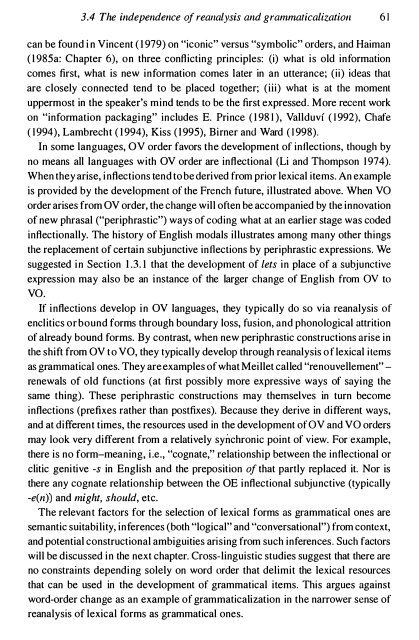Gram - SEAS
Gram - SEAS
Gram - SEAS
Create successful ePaper yourself
Turn your PDF publications into a flip-book with our unique Google optimized e-Paper software.
3.4 The independence of reanalysis and g rammaticalization 61<br />
can be found in Vincent (1979) on "iconic" versus "symbolic" orders, and Haiman<br />
(l985a: Chapter 6), on three conflicting principles: (i) what is old information<br />
comes first, what is new information comes later in an utterance; (ii) ideas that<br />
are closely connected tend to be placed together; (iii) what is at the moment<br />
uppermost in the speaker's mind tends to be the first expressed. More recent work<br />
on "information packaging" includes E. Prince (1981), Vallduvf (1992), Chafe<br />
(1994), Lambrecht (1994), Kiss (1995), Birner and Ward (1998).<br />
In some languages, OV order favors the development of inflections, though by<br />
no means all languages with OV order are inflectional (Li and Thompson 1974).<br />
When they arise, inflections tend to be derived from prior lexical items. An example<br />
is provided by the development of the French future, illustrated above. When VO<br />
order arises from OV order, the change will often be accompanied by the innovation<br />
of new phrasal ("periphrastic") ways of coding what at an earlier stage was coded<br />
inflectionally. The history of English modals illustrates among many other things<br />
the replacement of certain subjunctive inflections by periphrastic expressions. We<br />
suggested in Section 1.3. I that the development of lets in place of a subjunctive<br />
expression may also be an instance of the larger change of English from OV to<br />
VO.<br />
If inflections develop in OV languages, they typically do so via reanalysis of<br />
enclitics or bound forms through boundary loss, fusion, and phonological attrition<br />
of already bound forms. By contrast, when new periphrastic constructions arise in<br />
the shift from OV to VO, they typically develop through reanalysis of lexical items<br />
as grammatical ones. They are examples of what Meillet called "renouvellement" -<br />
renewals of old functions (at first possibly more expressive ways of saying the<br />
same thing). These periphrastic constructions may themselves in turn become<br />
inflections (prefixes rather than postfixes). Because they derive in ditl"erent ways,<br />
and at different times, the resources used in the development of OV and VO orders<br />
may look very different from a relatively synchronic point of view. For example,<br />
there is no form-meaning, i.e., "cognate," relationship between the inflectional or<br />
clitic genitive -s in English and the preposition of that partly replaced it. Nor is<br />
there any cognate relationship between the OE inflectional subjunctive (typically<br />
-e(n» and might, should, etc.<br />
The relevant factors for the selection of lexical forms as grammatical ones are<br />
semantic suitability, inferences (both "logical" and "conversational") from context,<br />
and potential constructional ambiguities arising from such inferences. Such factors<br />
will be discussed in the next chapter. Cross-linguistic studies suggest that there are<br />
no constraints depending solely on word order that delimit the lexical resources<br />
that can be used in the development of grammatical items. This argues against<br />
word-order change as an example of grammaticalization in the narrower sense of<br />
reanalysis of lexical forms as grammatical ones.
















